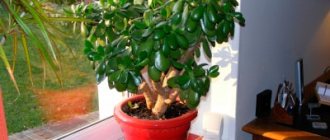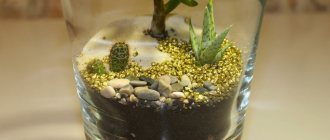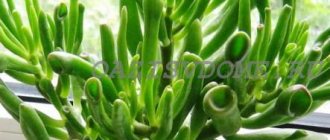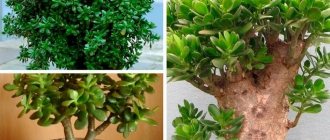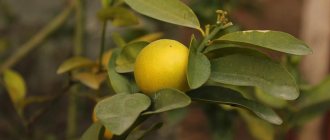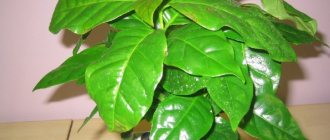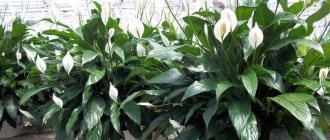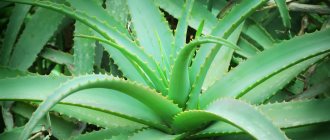Succulent lovers are sure to have at least one representative of the Crassula species in their collection. An unpretentious money tree is an elegant interior decoration. With proper care, Crassula will resemble a real tree with round coin-shaped leaves. There is a belief that a large money tree attracts wealth and prosperity to the house. Grown from a sprout, it can improve the home environment, bring not only aesthetic pleasure, but also be useful in the treatment of many diseases.
Name and botanical description
A succulent from the Crassulaceae family is called a money tree. Its Latin name is Crassula.
In everyday life, the house flower was given other names:
- penny tree;
- Crassula;
- coin tree;
- dollar tree (although this name is more typical for Zamioculcas);
- bear ear;
- the tree of Life;
- tree of luck.
This succulent is native to South Africa. There are many types and varieties of plants that differ greatly in appearance.
At home, the tree-like crassula is most often bred, which was given the name money tree for the shape of its leaves.
Tree Crassula looks like a tree with a thick gray-green trunk. As the succulent plant matures, the trunk becomes woody.
Money tree leaves are dark green or silver. The plates may have a red edge and are sometimes covered in spots. The surface of the leaves is glossy. They are shaped like coins. The size of one sheet is 4-7 cm.
The money tree indoor plant can reach 1.5 m. If desired, it can be trimmed so that the height does not exceed 50 cm.
Crassula is a slow-growing succulent. It reaches its maximum size only in the tenth year of life.
Popular varieties of tree crassula:
- Ovata;
- Purslane;
- Silver;
- Minor.
Also at home you can find columnar and ground cover (creeping) species of representatives of the Tolstyankov family. The first of them includes such a variety as Plaunovidnaya, the second - Perforata.
Description of the plant Crassula
Homeland of origin: South Africa. It has a thick, woody, brownish stem and many shoots, which gives the plant the appearance of a small tree. The leaves of the Crassula are also fleshy, semi-oval with an elongated base, and green. When kept in direct sunlight, especially in summer, the leaf blade acquires a reddish tint. The Latin name of the plant, crassus, comes from the word “thick” and has more than 300 species, but the money tree is one of the most common for growing indoors. It has several varieties with leaves of different sizes.
Money tree: how to properly care for it at home
Caring for a money tree at home includes compliance with the plant’s requirements for light, frequency of watering and fertilizing.
Location and lighting
The best place to grow a money tree is on the windowsill of a south-facing window. South-west and south-east directions are also suitable.
Crassula is photophilous. But varieties whose leaves are purely green may suffer from direct sunlight. Therefore, at noon such plants are shaded.
Signs of sunburn are the appearance of a red border around the edges and brown spots in the center of the leaf.
Variegated and flowering varieties are especially sensitive to lack of lighting. A signal that the money tree does not have enough light will be:
- loss of decorative color by leaves;
- lack of flowering in a plant that previously produced buds regularly;
- elongated shoots, uneven crown;
- thinning and falling leaves.
If there is a lack of natural light, the money tree is illuminated with lamps.
Expert tip: “Regularly turn the money tree pot so that it faces the light. Otherwise, it will not be possible to form a symmetrical crown.”
Fresh air is important for the fat woman, but drafts are contraindicated for her.
If the plant is placed on a windowsill in winter, make sure that the leaves do not touch the glass.
Temperature
In summer, room conditions are optimal for tree-like crassulas - 24-28°C. The money tree loves differences between day and night temperatures.
If in the summer the room is hotter than 30°C for a long time, it is necessary to increase the frequency of watering.
During the dormant period, which lasts from late November to early February, the money tree needs coolness. It is better to keep it at a temperature of 14-16°C. For example, a pot of crassula can be placed on a glassed-in loggia.
The main conditions are that the temperature should not fall below 8°C, and the fat plant should be protected from drafts.
If the money tree is not kept cool over the winter, it may lose its leaves.
| Period | Optimal temperature, °C | Limit temperature, °C |
| Summer | 25 | 30 |
| Winter | 15 | 8 |
Watering
Rules for caring for a money tree at home include 3 recommendations for watering:
- In summer, water Crassula abundantly, but not more often than once every 14 days.
- In autumn and spring, reduce the frequency of watering to once a month.
- During the dormant period, water the plant only after the soil has completely dried.
Water is poured slowly, trying to prevent the formation of puddles in the root zone.
Crassula, like all succulents, does not tolerate waterlogging. Therefore, water that has flowed out of the pot through the drainage holes must be drained.
Expert advice: “Don’t focus only on the top layer of soil. Do not water the fat plant until the substrate has dried 3-4 cm deep into the pot.”
A sign of insufficient watering will be wrinkled leaves. Excess moisture leads to rotting of roots, discoloration and falling of leaves.
Water the plant with filtered or settled water. It is advisable to do this in the evening.
Some gardeners use bottom watering for Crassula. They pour water into the pan and, if it is absorbed in less than 20 minutes, and the surface of the soil remains dry, they add more.
The video below provides recommendations for watering a money tree.
Air humidity
The fat woman does not like humid air. The money tree succulent does not need to be sprayed.
To remove dust, wipe the leaves of the plant with a damp cloth. You can wash Crassula in the shower, but you need to make sure that water does not get on the soil.
Crassula tolerates dry air well, even during the heating season. Its leaves have a sufficient supply of moisture so that unfavorable external conditions do not damage it.
If the pot with the money tree is in a room with high humidity, then the frequency of watering is reduced. In this situation, water the plant only if the leaves become soft or the soil is completely dry.
Top dressing
Caring for a money tree during the active growing season (from late May to mid-August) involves fertilizing. It will be enough to do this three times per season.
Store-bought fertilizers for cacti and succulents are recommended. Most of all, a money tree needs 3 elements:
- phosphorus;
- potassium;
- nitrogen.
But an excess of the second and third components also negatively affects the plant and causes the death of the roots.
Mineral fertilizers are taken with a concentration of 5:10:5, where the maximum dose is phosphorus.
It is preferable to use liquid fertilizers, which are applied after abundant watering. To dilute the dry composition, use settled water at room temperature.
Crassula only requires a quarter of the dose recommended for succulents.
Among organic fertilizers and “folk” recipes, the best option would be feeding with ash. It is poured onto the ground and buried a little deeper. A solution is also used: 200 g of ash is poured into a glass of water and infused for 7 days.
Bone and fish meal, and eggshells are suitable for fertilizing the money tree.
If an adult Crassula has been transplanted, it is not fertilized this year.
Find out how experts from the channel “Flowers in the House” recommend feeding the money tree. Houseplants”, you can see in the video below.
Care
Planting home crops in open soil is not recommended. If the weather is good, you can take the pot out into the fresh air. This procedure will have a beneficial effect on the well-being of the plant.
Worth knowing! Being outside, in the fresh air, often ends with the money tree being attacked by aphids. In order to recognize the problem in time and begin to fight harmful insects, it is necessary to periodically inspect the crop.
Despite the fact that Crassula has rather harsh living conditions in its homeland, there are some aspects that are worth knowing in order to grow a healthy flower in the house. Money tree care at home:
- Crassula loves light, but the plant does not like direct sunlight. To provide the flower with diffused lighting, it is recommended to place the tree on a stand or shelf under the window. In the summer, it is worth thinking about shading the glass (especially for south and south-west windows). On the north side, the plant is placed directly on the windowsill;
- Dry air is not a problem for succulents; due to frequent changes in humidity, various diseases can develop. The plant has difficulty adapting to frequently changing conditions;
- Adult Crassula has a negative attitude towards transplants, therefore, if there are no vital indications, it is best to leave the plant alone;
- Excessive watering leads to rotting of the root system, which ends in the death of the flower. In spring and summer, the crop is watered once a week. Use soft, settled water at room temperature;
- Frequent feeding should also be avoided. It will be enough for the plant to be fertilized once every six months;
- Contraindication – drafts, they provoke illness. If it is necessary to ventilate the room in winter, it is recommended to take the flower out of the room or cover it for this time. Prolonged exposure to cold air leads to the fact that leaves begin to fall off the crop.
On a note. The mealybug is not averse to settling on a money tree, which will cause both the plant itself and its owner great trouble. Periodic inspections of the flower and carrying out preventive measures will help to avoid this. If, however, harmful insects are found, you will have to use insecticides to treat the plant.
Content temperature
In spring and summer, the optimal temperature for Crassula is +20-25°C. With the onset of suitable weather conditions, it is recommended to take the flower outside or onto the balcony, because... the tree reacts poorly to insufficient fresh air.
Mealybug
In winter, the most comfortable mode is +15°C or lower, but not less than +4°C. If you overwinter a money tree at room temperature, you may encounter unpleasant situations such as wilting and falling leaves. It is not recommended to place the pot next to the central heating radiator.
The unpretentiousness of the Crassula makes the money tree a favorite of many gardeners. If all care recommendations are followed, the plant will look great, delight the owner for decades, and will not require treatment.
Formation of the Crassula crown
Caring for a money tree at home always includes pruning. If this is not done, the plant will be of irregular shape, with branches that are too long and break under their own weight.
They begin to give the crown the correct shape from the first days of life.
Principle of pruning the money tree:
- The lateral shoots of a young specimen are removed until the length of the bare trunk reaches 15 cm.
- When the total height of the crassula becomes 25-30 cm, cut off the crown under the two top leaves. This leads to the formation of side shoots.
- The cut is made at an angle of 45°. It is advisable to remove no more than ⅓ of the length of a healthy branch. If branches are removed completely, this should be done over brown rings (leaf scars).
- All cuts are sprinkled with crushed coal to protect the plant from infection.
- When the first shoots grow sufficiently, they are pinched (the top bud is removed) so that they also begin to branch. 4 pairs of leaves are left on each branch.
If, after pinching the shoot, not two lateral buds, but one, form on it, the procedure is repeated.
The described principle allows you to form a tree-like plant.
If a gardener wants to get a lush bush, he should not remove the side shoots of a young fat plant. But pinching will still be required. Otherwise, the cutting will grow without branching.
If you trim an adult plant, stumps will form in place of the removed branches. This procedure should be carried out in the spring in order to remove shoots and branches that have stretched out over the winter and grow inside the crown.
In the summer, only leaves that have begun to turn yellow or are out of shape are removed. In autumn and winter, the tree is not touched.
If signs of infection are detected, the damaged parts of the plant are cut off immediately, regardless of the time of year.
If it is necessary to rejuvenate the plant, total pruning is carried out, removing up to ¾ of the length of the shoots.
After pruning, as after transplantation, the money tree is kept in partial shade until it recovers from the procedure.
You can find out what mistakes gardeners most often make when forming the crown of a crassula from the video.
What if the tree has grown or only stretches upward?
- To form a crown, turn it towards the light in different directions.
- Periodically pinch the top.
- When it grows, cut off the excess branches, leaving 4 leaves. For work, use a disinfected pruner or a sharp knife. Treat the cut with crushed charcoal.
- Pinch out growing side shoots.
What to do if your plant does not want to bloom, dries out, or a white coating appears on it? Why do the leaves of the Crassula become soft and wrinkled, turn yellow and fall off? You will find answers to all questions on our website. Experts in the field of floriculture will tell you whether and how to save Crassula if it is sick.
Crassula (“money tree”) is completely unpretentious in care. But, in order to grow it beautiful and healthy, you need to learn in advance the simple rules of caring for the plant. Be always ready and help the flower cope with difficulties at any time.
Crassula flowering
With proper care for the money tree, it can bloom at home. Basic requirements for the formation of buds:
- sufficient illumination all year round;
- cold winter;
- good feeding and frequent replanting.
No matter how much the owner cares for the money tree, only mature specimens, older than 10-15 years, are capable of blooming.
Money tree flowers are small, with white petals, star-shaped and emitting a strong aroma. Flowering lasts for 2-3 months and occurs in winter.
Expert advice: “Flower buds are formed on young shoots in the fall. If you want the money tree to bloom, you need to prune it in early spring and not disturb it again this year.”
Another important condition for flowering is a sufficient amount of fresh air. The money tree will not produce buds if it grows in a poorly ventilated area.
Features of flowering
The money tree blooms infrequently, the flower itself is small in size, white in color with a pink center, the flowers are located throughout the crown. Flowering is possible no earlier than after 10 years of actual growth. The flowering of the money tree is beautiful in its discreet beauty, and in order to admire it, you must follow some rules:
- Plant access to fresh air.
- Regularly wiping the leaves from dust, spraying with warm water, proper watering - sometimes you need to give your tree a shower.
- Using special supports for the tree trunk.
- Timely removal of diseased or dry leaves.
Transfer
Caring for a money tree necessarily includes timely replanting. Young specimens require it annually, adults - once every 2-3 years.
If a gardener wants the Crassula to stop growing, he may not replant it at all. It is enough to change the top layer of the substrate once a year.
To change the pot and renew the soil, Crassula is replanted at the end of March or in April.
The first transplant is done 2 weeks after purchase. It can be postponed for a longer period if the plant was purchased in winter.
Pot
Crassula has a heavy crown and a rather weak root system. The main requirement for a money tree pot is stability.
The container for transplanting the Crassula should be wide, but not high. It is advisable to use a clay pot because... it is heavier.
A prerequisite is the presence of drainage holes.
For only rooted cuttings, use bowls with a diameter of 5-7 cm. For a young plant, take a small pot, no more than 10 cm in height and 20 cm in diameter, so that the roots do not grow to the detriment of the above-ground part.
The diameter of a pot for an adult specimen should not exceed the size of the crown of a money tree.
The soil
The soil for the money tree is loose, easily permeable to water and air.
You can buy soil for succulents at flower shops. It is also suitable for fat women.
Recipe for making your own substrate:
- turf land;
- leaf soil;
- humus;
- gravel;
- coarse sand.
Take 3 parts of the first component, one part each of the rest. Gravel can be replaced with agroperlite. Some gardeners add ash to enrich the composition.
Before transplanting the plants, the soil is disinfected.
Step-by-step instructions for transplantation
Drainage (expanded clay, pebbles) mixed with charcoal or activated carbon is placed at the bottom of the pot. This prevents the soil from becoming waterlogged and reduces the risk of the plant becoming infected with fungal infections.
If the plant is mature, with a massive crown, stones, bricks, etc. are placed under the drainage to prevent the pot from tipping over. You can also use different supports.
Step-by-step instructions for replanting a money tree:
- Remove the flower from the old pot. To make this easier, transplantation is carried out the next day after watering.
- Examine the roots of the plant entwined in the earthen ball. If they are healthy, place the tree in a new pot without removing the old soil.
- If rotten areas are found, clean the roots from the soil and remove non-viable roots.
- Sprinkle the cut areas with charcoal and let them dry (2-3 hours is enough).
- Place the fat plant in a new pot with a layer of drainage and substrate.
- Cover the roots with soil. The root collar should not be buried. The soil level should be the same as in the old pot.
- Compact, but do not compact the substrate, water the plant.
- Place the pot in partial shade for a week. The room should be cool.
If an adult specimen with a large crown was transplanted, several stones are placed on top of the soil. They are removed when the root system has established itself in the new soil (after 7-14 days).
You can see how the fat plant is transplanted in the video below.
What to do to speed up the growth of Crassula?
To renew and accelerate the growth of a succulent at home, it is necessary to reconsider its care:
- Check the size of the pot. Remove the plant from the flowerpot; if the lump of earth is large and not entwined with roots, replace it with a more suitable one.
- Replace the soil. Add: leaf soil, turf soil, coarse quartz sand or river pebbles.
- Adjust lighting. Place in the sun, but shade it from direct rays.
- Adjust soil moisture. Water only after the soil has completely dried.
If pests are detected, treat the plant:
- Mealybug - wipe with alcohol, vodka or soap solution. Rinse with a warm shower.
- Spider mites - treat with a solution of laundry soap, infusion of garlic, dandelion or onion peel.
Important! Be sure to treat the back side of the leaf properly, as spider mites settle there. - Shield. Soap solution. The disadvantage of this method is the need to repeat the treatment to get rid of hatched individuals. Examine the root of the crassula. While maintaining healthy roots, transplant into a new pot, removing all rotten tissue. Treat with charcoal.
Money tree propagation
The money tree can be propagated vegetatively, but only leaves and cuttings are used for this. It is impossible to divide the Crassula bush. If you cut the root, the newly formed plants will not take root.
Cuttings or leaves
Only an adult plant that is more than 3 years old is cut. The best time for rooting is March-April.
For propagation, you cannot use old, yellowing or, conversely, too young leaves.
If propagation is carried out by cuttings, choose a healthy and well-developed shoot from the middle of the plant.
Its optimal length is 5-10 cm. The branch must have at least 3 pairs of leaves and 3 nodes. You can use shoots that have produced aerial roots.
Step-by-step instructions for cutting money trees:
- Cut the stem cutting below the node with a sharp knife. Sprinkle the cut areas with crushed activated carbon.
- Remove the lower leaves so that they do not end up under a layer of soil.
- Dry the cutting by letting it lie in the air until it loses turgor.
- Without rooting in water, immediately plant the cuttings in a mixture of peat and sand. Deepen it no more than 5 cm. The soil should be slightly moist.
- As it dries, moisten the substrate with a spray bottle.
- After waiting until the cutting begins to grow and the young specimen reaches 10 cm in height, transplant it into a pot.
Do not deepen the crassula too much. The soil should only cover the roots. The leaf is rooted using the same principle.
The optimal temperature for germination of cuttings is 20-22°C.
If the grower wants to observe the appearance of roots, rooting in water is acceptable. Activated carbon and stimulants (for example, Zircon) are added to the glass. The water is not changed, only added as it evaporates.
You can learn more about vegetative propagation of the money tree from the video.
Using seeds
This is a rather rare and time-consuming way to propagate a money tree. Only experienced flower growers resort to it.
The best time to plant seeds is February.
Step-by-step instructions on how to grow a money tree from seeds:
- Cover the bottom of the container with drainage and cover it with substrate. Usually a mixture of two parts leaf soil and one part sand is used.
- Place the seeds and deepen them a little.
- Close the container and place in a warm (22-25°C) and bright place.
- Every day, ventilate the greenhouse for about an hour, make sure that the soil does not dry out, and if necessary, moisten it with a spray bottle.
- After the first shoots appear, remove the lid completely.
- After about a month, transplant the seedlings into a larger container.
The seedling is placed in the pot when it reaches 6-7 cm in height. The young fat plant is protected from direct sunlight and watered carefully.
In the first year of life, the succulent does not have a cool winter. The plant is not yet strong enough for this.
3. Varieties of Crassula:
3.1. Ovate Crassula, or Oval Crassula - Crassula ovata
An attractive evergreen tree with a strong trunk, which is often used for bonsai-style cultivation. The stem is thick, covered with dark brown bark, and bears abundantly branching shoots. The leaf blades are teardrop-shaped, green, glossy, and often acquire a burgundy tint at the edges when grown in direct sunlight. With age, plants of this subspecies can reach a height of 3 m, but this takes them more than one decade. Variegated varieties of this Crassula have green leaves with cream stripes or very bright pink leaves. Small white star-shaped flowers are collected in large inflorescences at the tops of the stems. The oval Crassula also includes the Sunset Crassula , a subspecies with brightly colored leaves. The main tone of the leaves is dark green, turning into orange or pink along the edge of the leaf blade. Over time, this species grows into a large tree.
↑ Up,
This variety also includes the tree-like Crassula Hobbit and Crassula Gollum, which have thick, rounded in cross-section, fleshy leaves, collected in whorls and resembling fingers. The upper edge of the leaves is flattened or even hollowed, and is often burgundy or reddish in color.
↑ Up,
3.2.Crassula lycopodioides
An evergreen succulent shrub up to 40 cm high with a very distinctive appearance. When looking at this plant, it is impossible to attribute it to the genus Crassula. The bush has thin, randomly curved, abundantly branched shoots of green color, densely covered with small, light green or bluish leaves, reminiscent of pine needles. With age, the stems become woody and covered with brown bark. The flowers are small, greenish-yellow, solitary or collected in few-flowered inflorescences.
↑ Up,
3.3.Crassula portulacea
Reminiscent of the species described above - the ovate carassa. With age, it turns into a beautiful tree with a compact crown of abundantly branching branches with dark green, teardrop-shaped, glossy leaves. Reaches a height of 2 m, the flowers are white or pink, small, but the flowering is very abundant and long-lasting.
↑ Up,
3.4.Pierced Crassula or Nile - Crassula perforata, Crassula nealeana
An unusually beautiful subspecies with erect, unbranched shoots, densely covered with triangular green or burgundy pairs of sessile leaves, reaches a height of 45 cm. The flowers are pale yellow, small, the main value is the attractive leaves.
↑ Up,
3.5.Schmidt's Crassula - Crassula Schmidtii
Unlike previous species, this gorgeous plant can be classified as an ornamental flowering plant. One of the smallest species - reaches only 20 cm in height. The stems are branched at the base, light brown, and contrast well with the dark green, oblong leaves. The leaves are thick, fleshy, oblong-triangular in shape, the upper surface has small depressions. During the flowering period, small inflorescences appear at the ends of the stems - umbrellas with bright, pink, bell-shaped flowers that do not exceed 5 mm. in diameter. There are plants with white flowers. Flowering is abundant and long lasting.
↑ Up,
3.6. Rock Crassula - Crassula rupestris
It is reminiscent of pierced crassula - the low erect stems of this species are densely covered with green or pinkish-yellow, thick, juicy leaves, as if beads strung on a thread. The leaves are triangular or rounded, have smoother outlines in contrast to the pierced crassula, and are often covered with a waxy bluish coating. Plants reach a height of 50 cm. During the flowering period, the plant throws out inflorescences - umbrellas with small white flowers.
↑ Up,
3.7. Crassula falcata
An evergreen succulent shrub that develops a short and thick stem with age. The main distinguishing feature of this species is the large bluish-green or gray, sessile leaves, arranged in pairs, as if emerging from each other. The plant can be classified as both decorative foliage and flowering. During the flowering period, crescent crescent forms a large inflorescence - an umbrella on a low, strong peduncle. The flowers are small, pink or salmon, have an attractive aroma, and bloom for a long time. Plant height varies and ranges from 60 to 120 cm.
↑ Up,
3.8.Carpet Crassula - Crassula socialis
Miniature evergreen perennial up to 6 cm high during the flowering period and less during the rest of the year. Over time, the plants form dense grassy mats. The leaves are juicy, thick, light green, triangular, reaching a length of 4 - 6 mm. and tightly cover the stems of the plant. When grown under the scorching rays of the sun, the leaves may take on a pinkish color. During the flowering period, which occurs mainly in late summer - autumn, vertical, leafless peduncles form at the tops of the stems. At the tops of the peduncles there are small branched inflorescences with small, white flowers.
↑ Up,
3.9.Crassula picturata
A spectacular decorative foliage succulent with strong, erect shoots branched at the base. The leaves are thick, sessile, heart-shaped or lanceolate, often covered with slight pubescence, and arranged in opposite pairs. The leaf blades are light green, velvety, with small, dark specks and a thin border along the edge. With prolonged exposure to the sun, the leaves turn pinkish. Small terminal inflorescences appear in the warm season and consist of small, pinkish or white flowers.
↑ Up,
3.10. Helms Crassula - Crassula helmsii
A herbaceous succulent perennial plant with rounded, lodging stems about 1 mm thick, up to 130 cm long. The leaves are succulent, thick, needle-shaped, reminiscent of needles, light green in color, reaching a length of 2.5 cm. During the flowering period, the plants form small, inconspicuous, axillary, white flowers with 4 pointed petals.
↑ Up,
3.11. Milford's Crassula - Crassula milfordiae
An evergreen groundcover succulent that forms thick, herbaceous mats reminiscent of saxifrage. The stems are thick, creeping, abundantly branched at the base. The leaves are sessile, light green, burgundy, pink or covered with a bluish bloom, collected in whorls, often with a small attractive pubescence on the surface. The leaf blades are triangular. In the summer months, the plants adorn themselves with strong, erect, thick flower stalks with inflorescences called umbrellas at the top. Each umbrella consists of several white or pink, small, delicate flowers.
↑ Up,
3.12.Crassula tomentosa
A miniature biennial or perennial plant with leaf rosettes consisting of glossy, green leaves covered with rich silvery pubescence. The leaf blades are rounded, reaching a diameter of 3 - 10 cm. During the flowering period, the plants form a thick, erect, unbranched stem 10 - 60 cm high, on which the leaves are arranged in opposite pairs. At this moment, plants often resemble a child’s toy - a pyramid, since the higher the leaves are, the smaller they are. Each rosette can bloom only once - then it dies, leaving numerous offspring around it.
↑ Up,
3.13.Crassula lactea
Perennial succulent plants with thick, branched, succulent, brown stems up to 40 cm high. The leaves are light green or bluish green, sessile, heart-shaped, arranged in opposite pairs; when grown in direct sunlight, they can acquire a bronze or slightly pinkish tint. An interesting feature of the plant is the presence of small, white dots along the edges of the leaves. This variety blooms very profusely. Short, strong flower stalks appear at the tops of the shoots and bear inflorescences - umbrellas consisting of numerous white or pinkish flowers.
↑ Up,
3.14. Marnier Crassula - Crassula marnieriana
Extremely attractive ornamental foliage plants with thick, branching, branched at the base, erect or lodging stems. This plant can be used both as a spectacular ground cover and as a hanging specimen when grown in a hanging pot. The leaves are light green or bluish, very thick, succulent, sessile, widely triangular, densely covering the stems. With prolonged exposure to the sun, the ribs of the leaves turn a bright burgundy or pinkish tint, which gives the plant additional attractiveness. In the summer months, short flower stalks appear at the tops of the shoots, on top of which there are small inflorescences with many pinkish flowers.
↑ Up,
3.15.Crassula 'Morgan's Beauty
A bright, compact beauty up to 10 - 30 cm high. The low, powerful stems of this plant bear wide - triangular, thick, succulent leaves. The leaf blades are green, covered with a thick, silvery-blue coating. The flowers are bright pink or crimson, collected in large, rounded umbrellas, contrasting well with the foliage.
↑ Up,
3.16.Crassula Undulatifolia - Crassula arborescens subsp. undulatifolia
Tall succulents with thick, branching shoots that become woody with age and become covered with light brown bark. The leaves are bluish or light green, oval, on short petioles, arranged in opposite pairs. The leaf blades are entire, have a beautifully curved shape, due to which the plant appears curly. With age, this variety can reach a height of about 2 m, but it develops slowly. White or pink, attractive flowers are collected in terminal umbels.
↑ Up,
3.17.Crassula Nudicaulis
The erect stems of this plant are bright brown and covered with many thick, succulent leaves. The leaves are light green, sessile, thick - almost round in cross-section, narrowly lanceolate in shape. The leaf blades are often painted a bright burgundy shade. The flowers are small, inconspicuous, greenish or cream, and always remain half-closed.
↑ Up,
3.18.Crassula pyramidalis
A spectacular representative of Crassula with thick stems, which in older plants branch at the top and form a lush crown. The leaves are glossy, green, triangular, reach a length of 8 mm, and are arranged so densely that they create the appearance of tetrahedral, thick stems. The inflorescences are apical, tightly adjacent to the stems and consist of small salmon-colored, white or pink flowers.
↑ Up,
Diseases and pests
Crassula can be affected by a fungal infection, gray rot. Development is promoted by regular overwatering of the plant and lack of fresh air in the apartment.
Several types of pests can parasitize the money tree.
| Parasite | Signs | Fighting methods |
| Shchitovka | Brown or yellowish bumps on leaves | soap solution (Fitoverm) |
| Spider mite | Web between leaves and stem | The pest is removed with a swab soaked in alcohol. The plant is treated with insectoacaricides or acaricides |
| Aphid | Yellowish spots on the leaves. Insect colonies on the bottom of the plates | Treatment with soap solution and insecticides |
| Mealybug | Plaque in the leaf axils | Bathing the plant in the shower and using insecticides |
The appearance of parasites indicates that the plant is kept in extremely unsuitable conditions.
Features of watering plants by season
- Winter is the resting time of the Crassula. The temperature is cool, from 7° to 12° is normal. A suitable place is on the terrace, closed loggia, veranda. Beware of drafts and excessive heat, otherwise the trunk will shed its crown and remain bare.
- Spring , warm days have arrived, the plant will begin to gain strength and beauty. Start watering the tree 2 times a month.
- Summer , time of heat, time of abundant watering. Use a wooden stick to check the dryness of the substrate. Only after 2-3 cm deep has dried out, water again. The leaves of the tree are able to collect and retain moisture, which will last for a long time.
- In autumn, watering should be minimized. The fat woman is preparing for winter rest.
When watering, make sure the tray is dry.
There is one peculiarity: when a tree wants to “drink”, its leaves become soft. Crassulla does not need spraying; wipe off dust with a soft damp cloth.
Common mistakes and problems in growing
The money tree rarely gets sick or is attacked by pests. More often, the loss of decorativeness is associated solely with errors in care. The main ones are given in the table.
| Problem | Probable Cause |
| Thinning leaves | Overwatering |
| Falling leaves in winter | Room too warm |
| Fall of leaves in spring and autumn | Excess fertilizer. Watering with cold water. Excess moisture. Root rotting |
| Root rotting | Excess moisture, especially during the dormant period when kept in a cool room. |
| Yellowing of leaves | Lack of lighting |
| Wilting of leaves. Light or black spots on the plates | Sunburn |
| Dry reddish crust on leaves | Soil depletion. Stagnant air in the room. Sunburn |
| Dry brown spots on leaves Loss of turgor | Lack of moisture |
| White dots on leaves | Excess moisture |
| Darkening of the trunk | Excess moisture |
| The trunk has become soft | Lack of light. Excess moisture. Heat |
Since the money tree is considered an unpretentious plant, it is often planted by inexperienced gardeners.
No matter how hardy it is, the owner’s mistakes affect the condition of the Crassula. Because of them, it loses its decorative effect and sometimes dies.
The consequences of most of them are solved by changes in care. Overwatering can cause root rot and death of the money tree.
Why do the leaves of the Crassula money tree turn yellow?
The problem arises for a number of reasons. The first and most common is an incorrectly selected pot. Due to crowded conditions, the money tree or homemade crassula begins to lose leaves and turn yellow. The problem can be solved by selecting another container with a larger diameter. The second reason for yellowing leaves is lack of watering or excessive soil moisture. First, the roots of the plant suffer, and then the rot spreads to other parts of it.
Increased temperature and dryness in the room are another reason why the leaves of the money tree bearberry fall off. In this case, the flower must be removed from the windowsill and provided with timely watering. Another way out of the situation is to purchase an air humidifier and place containers of water next to the crassula. The room in which the diseased plant is located must be regularly ventilated.
Benefits and harms
It is believed that the phytoncides secreted by the leaves of the fat plant are capable of disinfecting the air. And its juice is credited with the ability to help with a variety of problems, including:
- inflammation of the gums;
- insect bites;
- calluses, etc.
Anyone who decides to try traditional medicine recipes must remember that Crassula is a poisonous plant. Its juice can only be used externally.
Crassula leaves are capable of accumulating arsenic.
Plants that are grown in arsenic-free soils are considered safe.
But still, the home money tree should be kept out of the reach of animals and small children and caution should be exercised when using popular advice.
Reproduction
Crassula propagation occurs by cuttings or shoots. Twigs, large leaves, trimmed or fallen from the tree are suitable. There is no difficulty in rooting cuttings for propagation. This is from the “simple” category. Pre-dry the propagation material, then plant it in the soil. To disinfect, add charcoal to the soil. After half a month, the cuttings will take root; it’s time to transplant them into a separate container.
Crassula is also grown from seeds. Pre-soak the seeds overnight. Discard any floating seeds; they are not suitable for growing a tree. Soften the crust of healthy seeds a little with a blunt object and sow in a container with prepared soil. Cover with film to create a greenhouse effect. Ventilate and pollinate periodically. After 2 weeks, sprouts will appear that can be planted in flower containers.
Signs and beliefs
If a person believes that a money tree will bring him prosperity, he should know well how to care for it.
According to the superstition, only a healthy Crassula will be the key to wealth. A sick fat woman attracts financial failures.
Also, to increase wealth, follow 3 rules:
- Crassula cuttings are asked from relatives or close friends and grown into an adult tree on their own;
- Coins are buried in a pot with a money tree, they are placed on the bottom with the coat of arms facing up;
- Crassula branches are decorated with coins, which are hung on red cords.
According to Feng Shui, the money tree is placed in the wealth zone, in the southeastern part of the apartment.
There is also a belief that the fat woman is an indicator of the atmosphere in the family. No matter how properly the money tree is cared for, it will wither if the owners constantly quarrel or if a seriously ill person lives in the house.
At the same time, many Crassula owners believe that it is able to smooth out a negative environment and fill the house with positive energy.
Several folk signs for the money tree:
- Crassula flowering is a signal of a quick increase in family income;
- give or throw away the fatty - lose money;
- the plant loses leaves - to the collapse of the business;
- a pot with a money tree fell - to a loss.
You can learn more about the signs and superstitions associated with the money tree from the video.
Feng Shui planting
Crassula got its popular name - the money tree - thanks to its leaves that look like coins. This plant attracts financial well-being to the home. To increase the effect you need to know some secrets of planting this plant :
- Crassula cannot be purchased. It is best to take a cutting from friends who do not have financial problems. Then the tree will be charged with positive energy. We do this in secret; there is no need to inform the owner of the plant.
- In order for the fat plant to improve your financial situation, you need to plant it yourself.
- According to the teachings of Feng Shui, the color of money is a combination of earth and metal shades. Therefore, the money tree bowl should be golden, red, black or brown.
- Before planting the plant, place 6 or 8 coins of the same denomination at the bottom of the pot.
The coat of arms should look up. We use money from the country in which we live. Important ! When arranging coins, pay attention to the drainage holes; they should be left open. - For financial well-being, it is important to choose the right place for the money tree. According to Feng Shui, this place will be the center or southeast of the room.
- Under the pot we place a red napkin with a hieroglyph meaning wealth.
- We decorate the tree with Chinese coins on a red ribbon.
For the fat plant, the same principles of maintenance apply as for other succulents. And in gratitude for proper care, the money tree will not only affect your financial well-being, but will also delight you with white or yellow flowers.
Answers to popular questions
How long does the fat woman live?
The average lifespan of one specimen is 20-30 years. With proper care, a money tree can live up to 50 years.
Is it possible to save a tree that has lost its decorative properties?
If the fat plant has shed its leaves due to a too warm winter, it will produce new shoots from which a new crown can be formed. If the reason for the loss of decorativeness is rotting and death of the roots, you need to grow a new specimen by cuttings.
Is it possible to leave the plant without care during the holidays?
Crassula can live for a month without watering, even in summer. Before leaving, water the money tree more abundantly than usual, mulch the soil, and place the pot in the shade.
Why can’t I form a round crown?
If the money tree is bent and stretched, this is a sign of lack of light.
Why doesn't the money tree grow?
There can be many reasons for this situation, from an unsuitable pot and improper watering to rotting roots and pest infestation. You need to replant the plant, make sure the roots are healthy, and use enough drainage. It is also necessary to adjust the watering regime. Stunting of growth is normal if it occurs in winter.
Why do Crassula cuttings not take root?
If rooting is carried out at the right time of year, then the main reason for the mass death of cuttings is their insufficient drying. In order for a Crassula leaf or twig to produce roots, they must be well “withered.” The cutting is ready for rooting when it has lost its shine and turgor and has become wrinkled.
How to properly place it in a pot?
Once the cuttings and leaves have taken root, they can be planted in separate pots. The procedure is as follows :
- A correctly selected pot is filled one third with drainage (for example, expanded clay).
- We fill the soil and, without compacting it, moisten it a little.
- We make a small depression in the center and place the cutting there to a depth of 3 cm. Sprinkle the top with soil.
- You can install supports to help the plant grow evenly.
- Place the pot in a well-lit place, avoiding direct sunlight.
- We moisten the soil as it dries.
As soon as new leaves appear on the young tree, you can be sure that the rooting process was successful.
Medicinal properties of Crassula
Work aimed at a full study of the composition of Crassula has not yet been carried out in full. However, the plant has certain medicinal properties, therefore it is widely used in folk medicine. Some healers, knowing the beneficial and healing properties of the culture, compare the fat plant with aloe, which is due to the wide range of uses of plant raw materials for medicinal purposes. In folk medicine, money tree-based remedies are used to prevent and treat the following diseases:
- sore throat and tonsillitis;
- inflammatory processes of the gums;
- herpetic manifestations;
- hemorrhoids;
- wounds, bruises, abscesses, cuts, frostbite and burns;
- calluses and corns;
- arthritis;
- phlebeurysm.
When used for medicinal purposes, it must be remembered that there is a certain amount of arsenic in the juice of the Crassula juice, and its excessive consumption causes severe poisoning. Therefore, before treatment with drugs based on Crassula, all contraindications must be studied, and a consultation with the attending physician must be obtained.
Types of Crassula with photos and names
There are many types of money tree.
They can all be divided into three groups:
- tree-like. In the photo they look like a large mature tree. Can grow to enormous sizes;
- columnar. They look like bushes, grow upright, and almost always have no branches;
- creeping. They grow in width.
Diseases, problems
Pests do not like a healthy money tree. Spider mites, aphids, mealybugs, and scale insects cannot be fooled. An oversight in care and pests will “settle” on the fat plant. Flooded wood will cause rot. Lack of light will “serve” the leaves to stretch. The scorching rays of the sun will “cause” a burn, the leaves will become covered with black spots. The tree is too dry - the leaves will begin to dry out and fall off, like from an autumn street tree.
The belief is that the tree reacts to the state of the household. If the people living in the apartment are unwell, the tree also begins to wither.
Conclusion: Crassula, the money tree of the house, is a family talisman. Look after it, take care of it, and it will bring, if not prosperity, then certainly pleasure.
